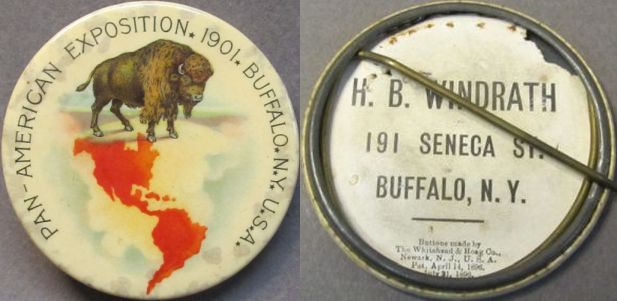
Celluloid Encased Coins
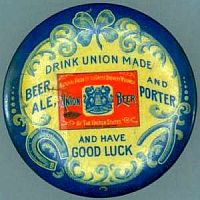

Union Made Beer Celluloid Encased
Encased coins are thought to first have made in 1901 for the Pan-American Exposition. Originally aluminum was used as the outer ring to encase a 1-cent piece. Aluminum is
thought to be used due to it being relatively inexpensive and easy to press with advertising slogans. The majority of encased coins have a slogan similar to Keep Me and Never Go
Broke
or Keep Me and Have Good Luck
. There are variations of this theme, but the thought was that people would keep the encased coin as a pocket piece and thereby keep the
business name and information top of mind
. At the Pan-American Exposition, several kinds of encased coins were sold as souvenirs, including round, horseshoe shaped, frying pan
shaped and round vulcanite encased. Vulcanite
is a plastic material made by mixing rubber and sulfur. It was invented and patented by Charles Goodyear in 1846.
Sometime after the Pan-Am Expo another type of encased cent was introduced. The encasement was made of celluloid
. Celluloid is a plastic compound created in the 1850's, using
nitro cellulose and camphor. Nitro cellulose is a flammable compound and camphor a white crystalline powder which emits flammable fumes. It was the first synthetic plastic ever
used. Dyes and other agents were added for color and stability. The material is easily molded and shaped and was widely used as an ivory substitute. It was mainly used in the
motion picture industry and commercial photography. Celluloid as a film medium was first thought to be have been used by Thomas Edison in his early motion picture experiments.
It is highly flammable and was replaced by acetate in the 1950's for film.

The piece above advertising Ramos Gin Fizz / Gin Phizz
. The colors and smooth surface plus the ability to print the slogans made this a step up from the
aluminum encased. This particular piece is advertising a popular New Orleans drink. The drink was first served at Henry Ramos' Imperial Cabinet Saloon in 1888. It is a frothy
gin drink still made today. The Ramos piece is 28 mm in diameter and, as can be seen from the image, the coin side has no room for any additional inscriptions.
I style these as "button" encased because the rounded top of the encasement is very button like. While smaller that political buttons, they are very similar to political
advertising buttons of the same period. I have two other "button" encased from the same manufacturer. The Ramos piece has a 1942 wheat
cent; the J.C. Wineman & Co., a 1904 Indian; and the Knickerbocker Jewelry Co., a 1902 Indian. The only thing I can be sure of on a manufacturing time line is that the Ramos piece was made
in or after 1942. Note that the design is identical on all three pieces with the text in the shield area. The design includes a wishbone
, rabbits foot
, horseshoe
,
and a four leaf clover
. All of which are symbols of good luck, which is also included on the piece. The J.C. Wineman & Co is from Washington D.C and was a tailor.
(Footnote:
As Listed in Boyd's Directory of the District of Columbia - click on link for more information)
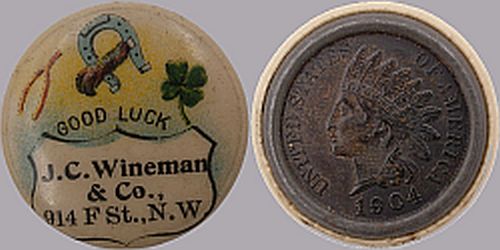
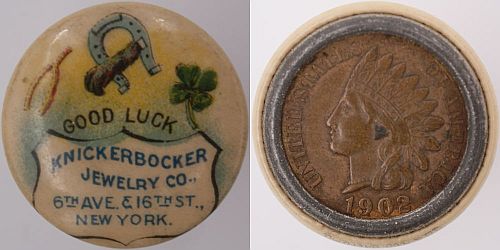
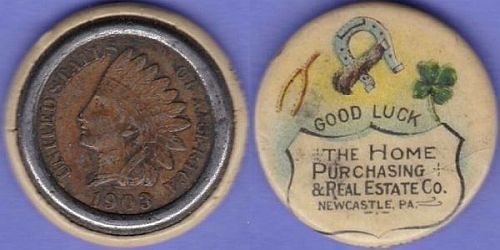
Above are three additional BB & N Co. /Balto. MD.
encased celluloid cents.
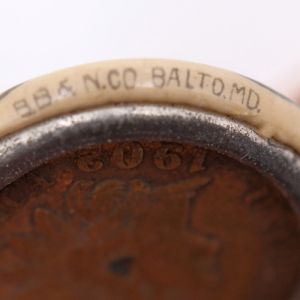
All four pieces have Mfg. By B.B. & N. Co./ Balto., MD
on the edge of the celluloid. Research has shown that this is the Baltimore Badge & Novelty Co.
- I
have one additional piece of the same size (22 mm) but with entirely different printing, It says, Land of Lincoln ' BALBO / Makes Cents
, which has a 1964-D cent. The manufacturer of this piece is currently unknown.
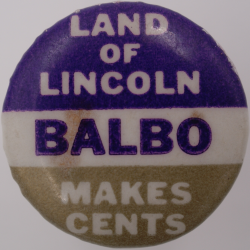
A "Google" search turned up nothing on the candidate although it must have been an Illinois political office.
This celluloid encased cent is from Neekoosa, Wisconsin. The coin side reads, Compliments of A. Zurfluh, Neekoosa, Wis. Xmas 1901
. The celluloid side reads:
KEEP • ME • AND • NEVER • GO • BROKE
I BRING GOOD LUCK
. The piece is 42.5 mm in diameter. The button encased above manufactured bu Baltimore Badge & Novelty Co.
are 28mm in diameter. The four leaf clover and horseshoe images are the central design on the celluloid side. The manufacturer of this piece is currently unknown.

Here is an additional celluloid encased that I do not own. I will happily give credit to the owner or remove if requested.
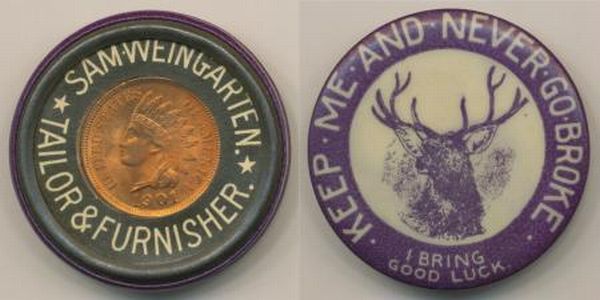
Whitehead & Hoag

Whitehead & Hoag Chester Hoag, left, (1860-1935) and Benjamin Whitehead (1858-1940) formed Whitehead & Hoag in 1892.
Benjamin Whitehead was a printer, printing programs for local picnics and parties. He also printed badges on silk. He and Chester Hoag had a business relationship, which became
a friendship and then a partnership that was incorporated in 1892. It was soon to become the country's largest manufacturer of advertising novelties. The company acquired three
major button patents prior to its immediate step into button creation in 1896. A patent, filed Dec. 6, 1895, established the reverse design of celluloid buttons. Issued as a
"jewelry" patent to George B. Adams, assignor to W&H, it specified a shell with a marginal rim to form a chamber and contain a continuous piece of wire with both a holding portion
and a free end lying in the same plane.
The following celluloid encased are products of the Whitehead & Hoag Co. at the bottom of the coin side.

Note the Whitehead & Hoag CO., Newark, N.J.
on the coin side.
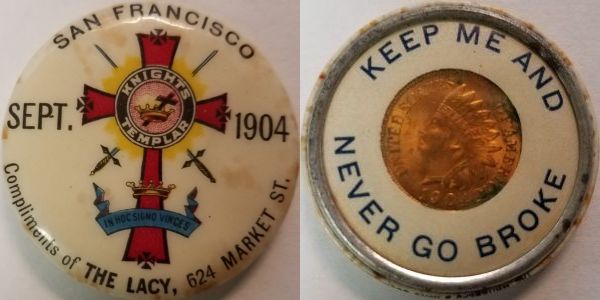
This piece is interesting in that is has a cross of the Knights Templar in the center. This cross is know as a Passion Cross
. It rests on top of two crossed swords.
Their motto In Hoc Signo Vinces
, (By This Sign Thou Shall Conquer, is a literal translation) is on a ribbon at the bottom of the cross. Google maps shows 624 Market Street, in the middle of the intersection of Market and
Montgomery Street. Searches for The Lacy
do not return any relevant information. Also of interest are the four Maltese Crosses
at the ordinal points of the cross. Finally I wonder what the significance of September 1904?
Markus Molenda added some information on this piece.
This celluloid encased cent was issued on the occasion of the Knights Templar 29th Triennial Conclave,
held in early September 1904 in San Francisco, CA. The festivities extended from August 31 to September 6
and culminated in a three hour long parade that passed through the length of Market Street to Van Ness Avenue.
(Note, the dates of the festivities differ from the above in some sources, but all include Sept 6, the day of the parade.)
Some photos of the parade can be seen here:
Knights Templar 29th Triennial Conclave Parade Photos
The issuer identified on the encasement as The Lacy at 624 Market Street was in actuality a saloon called
The Lacey (note the different spelling), operating at the given address. The saloon opened in January 1903
under the ownership of Charles F. Sliter & George L. Birdsall. In November 1903 the proprietors changed to
Charles F. Sliter & Andrew C. Dibble, and remained so until August 1904 when C. F. Sliter left the partnership.
In an August 31, 1904 advertisement in the Pacific Wine & Spirit Review, the saloon's owner was listed as solely A.C. Dibble.

It is likely that the token was ordered under the ownership of Sliter & Dibble, and then handed out during the festivities
after Sliter had left, given the time required to receive and fill the order for the encased cents.
Dibble continued to run The Lacey, with various partners, until April 1906. On the 18th of that month
San Francisco was hit by a devastating earthquake, and the saloon was destroyed by the ensuing fires.
Various photos of the neighbouring Humboldt Savings Bank show part of what remained of the destroyed saloon.
The saloon was rebuilt in the same location immediately after the earthquake.
However, the street numbering on Market Street had changed at that point in time, and the saloon was listed at 640 Market Street.
In August 1906 A. C. Dibble sold the saloon to William Schreiber who owned it until its closure in 1914.
Whitehead & Hoag were making ribbon badges and celluloid parts when the "button" was patented. Their idea swept the country. Buttons were used as advertising buttons and political campaign buttons. Their first big order went to the American Tobacco Co., at the rate of 1 million a day.
How many of the encased buttons were made? No one knows. They are similar to encased mirrors and political buttons as the print side is smooth and shiny. Encased mirrors have the coin embedded in the print side and have an inexpensive polished steel plate for a mirror. Political buttons are usually pin back items with a political slogan.
Below is an example of a "pin back" celluloid that Whitehead & Hoag made for the 1901 Pan American Exposition.


The above image clearly shows the Whitehead & Hoag
copyrights from April 14, 1896 and July 31, 1896 in small print at the bottom. The H. B. Windrath 191 Seneca St., Buffalo, N.Y.
is probably the vendor that sold them at the Expo.
The encased mirrors below are shown for contrast and to illustrate other celluloid coin related products. I do not know the manufacturer of this piece.

Celluloid encased 1910 cent - advertising mirror for Shulman's garments.
Below are new celuloid piece I recently acquired. After an exhaustive search, I have not been able to find much about the Blue Beacon
token. The best guess I have is that this relates to the Blue Beacon Truck Wash, which operates 110 truck/rv washes in the 40 states and Canada. Ir is the same size as the Baltimore Badge & Novelty Co.
piece at the top of the page. Manufacturer is unknown.
Button top blue lettering on a white background reads: BLUE BEACON 5¢ / THIS TOKEN MUST BE RETURNED WITH THE BOTTLE / BOTLE DEPOSIT
Reverse shows a 1953 D cent.
The Perfection Wafers
piece is 42.5 mm. The cent is 1902. I have been unable to find any information on this piece on the internet.
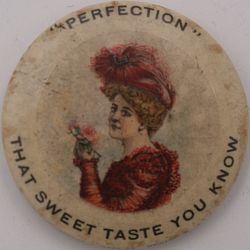
Obverse reads: PERFECTION / THAT SWEET TASTE YOU KNOW
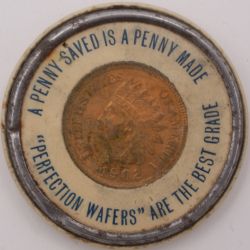
Reverse reads: A PENNY SAVED IS A PENNY MADE /
PERFECTION WAFERS
ARE THE BEST GRADE
Home | Articles | Varieties | Coin Links | About | Terms of Use
Site Copyright 1999-2021 by Bruce Perdue Email: Webmaster All Rights Reserved ©Copyright Bruce Perdue
